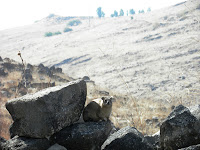It all started in ~1070 when Byzantine emperor Alexios I appealed to Pope Urban II for mercenaries to help him resist Muslim advances into the territory of the Byzantine Empire. The "Reply" email button was not yet invented at the time, but this did not bother Urban at all, as he had more important business to attend to, like figuring out what's in it for him. This took him a mere 25 years. In 1095, in one of the most influential speeches ever made, Pope Urban II launches the Crusades at the Council of Clermont.
Why did he do that? To restore Christian access to the holy places in and near Jerusalem. Why did he really do that? To improve his own status vis a vis his fellow Patriarchs (him being one of five equals before the East–West Schism) and vis a vis Europe's secular leaders (showing them his strong influence over their people), and to clear Europe from the many knights challenging the feudal landlords and fighting each other, by channeling their energy towards a 'just cause'. To ensure a high number of participants, he granted them plenary indulgence and promised feudal fiefdoms, land ownership, wealth, power, and prestige. These ingredients yielded the 200-year, fascinating historical chapter of the Crusaders in the Holy Land, where as a conquering minority, Crusaders were confined mainly to fortified cities and castles, such as Monfort and Belvoir (Kochav Hayarden), the two main sites of our trip.
As you can guess from this photo, the way between the parking lot and the fortress remnants is quite rocky and goes down- and then uphill. Once up, we visited the dungeon, refectorium and fortifications, and indulged in the pretty sight of Kziv creek.
 From there, we took scenic route 89 to the ancient synagogue in Korazinm National Park. The site is quite small, but the geometric, floral and faunal patterns carved in basalt are exquisite. During the short walk, we spotted lizards sunning themselves on the rocks and hyrax climbing the impressive Christ-thorn jujube trees.
From there, we took scenic route 89 to the ancient synagogue in Korazinm National Park. The site is quite small, but the geometric, floral and faunal patterns carved in basalt are exquisite. During the short walk, we spotted lizards sunning themselves on the rocks and hyrax climbing the impressive Christ-thorn jujube trees. Next, we cooled ourselves by taking the wet route in the Majrase, which means walking in the Daliot stream, amidst lush greenery and small school of fish swimming away from our footsteps. On the way out, we picked blackberries as the appetizer of our fish lunch with a view at Bet Gavriel.
Next, we cooled ourselves by taking the wet route in the Majrase, which means walking in the Daliot stream, amidst lush greenery and small school of fish swimming away from our footsteps. On the way out, we picked blackberries as the appetizer of our fish lunch with a view at Bet Gavriel.
Our last site was the concentric Belvoir fortress in the Belvoir National Park, the best-preserved Crusader fortress in the country. Our visit included the moat, glacis, double gates, water cistern, Jordan valley view, external barbican, warehouses, watchtowers, refectorium, church, and the neat secret passage called poterna, which for some reason appears here 90 degrees rotated counterclockwise.
From Belvoir, we continued south, following the Jordan valley and because it turned too late to visit Qasr el Yahud, we turned west and crossed the Samarian hills on the way home, with the sun setting in front of us.
What a great trip!
Check out the rest of the photos here.










No comments:
Post a Comment